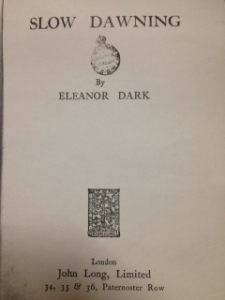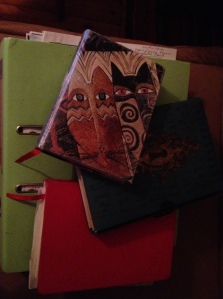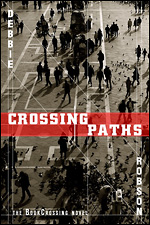 I‘ve been doing that for quite a while now for two very different reasons but I had better start at the beginning. I first discovered that I really wanted to read Eleanor Dark‘s first novel way back in the early 1990s. I was researching my third manuscript set between the wars and as the tone of the times (as I like to think of it) is always very important to me I generally try and read at least a few books written during the time that I am researching. By then I had read Prelude to Christopher and thought it marvellous so I was quite interested in reading Eleanor Dark’s very first novel. I can’t recall the exact details but it became obvious that there were limited copies available and I think I had to either try and buy a copy online (which I never attempted) or read the book at the Mitchell Library. Also impossible with a young child and a very unsympathetic husband.
I‘ve been doing that for quite a while now for two very different reasons but I had better start at the beginning. I first discovered that I really wanted to read Eleanor Dark‘s first novel way back in the early 1990s. I was researching my third manuscript set between the wars and as the tone of the times (as I like to think of it) is always very important to me I generally try and read at least a few books written during the time that I am researching. By then I had read Prelude to Christopher and thought it marvellous so I was quite interested in reading Eleanor Dark’s very first novel. I can’t recall the exact details but it became obvious that there were limited copies available and I think I had to either try and buy a copy online (which I never attempted) or read the book at the Mitchell Library. Also impossible with a young child and a very unsympathetic husband.
Life moved on. For me there was a divorce and a move up the coast, a World War II novel (Tomaree), a contemporary novel (Crossing Paths: the BookCrossing Novel) and then a manuscript set during World War I (The Grey Silk Purse). As research for that book I thought I would finally attempt to read Slow Dawning and this is when the waiting really began.
In July 2011 whilst researching transport during WWI, I requested Slow Dawning along with another book. I did this online during the week to make sure both books would be available for me after I got off the Newcastle train and arrived at the Mitchell Library in Sydney. On arrival I was told that Eleanor wasn’t there. I said I requested it. The staff nicely informed me there was a delay of about half an hour. She couldn’t be quickly located.
By the time the book turned up I was deep in my other research and only gave the novel a cursory glance. I was still at this stage thinking I could read it in several sittings or just glance through it and dismiss it (particularly after what Eleanor Dark’s biographer had written about the book). I did neither. I decided I really wanted to read it but wasn’t sure how I could achieve this as I knew by 2011 that the book couldn’t be bought online. Surprisingly no second hand book shop on the net had it available for sale (and still doesn’t). I reluctantly returned the book and thought I would have a look at it again next time I was at the Mitchell and hopefully not as busy.
On Saturday, 26 January this year I arrived off the train, keen to have another look at Slow Dawning. It was my main focus this time. I went to the desk to pick the book up and they told me it wasn’t there and would take a while for them to find it. I said this had happened last time and why couldn’t it be ready when I put a special request in for it? They didn’t know. I was frustrated and beginning to wonder why this book AND ONLY THIS BOOK kept me waiting. It arrived and I began to read Slow Dawning. Because of the delay in arriving I didn’t have much time with the book and was now more determined than ever to read it.
I took it to the front counter and asked if I could photocopy the book. They said yes and calculated the cost – approximately $30. Being a starving artist I didn’t have the money to spare that weekend but promised myself I would be back in a few months to finally read Eleanor Dark’s first novel. What a mission!
On Saturday 1st June I had an awful trip down on the train, missed my connection and had a wait at Gordon station. By the time I arrived at the Mitchell I was already very frazzled and precious time had again gotten away from me. I went to the front counter to pick up the book (as before ordered online for a quick pickup) and was told AGAIN the book wasn’t there! They couldn’t locate it. WELL… you can imagine what sort of mood I was in! I made a fuss (as much of a fuss as anyone can make in the hallowed rooms of the Mitchell Library). I was asked if I wanted to make a complaint. I said yes I did, mainly, I explained because obviously there was something wrong with the cataloguing of this particular book. I filled out the form (still haven’t heard anything back) and waited.
Finally after about thirty five minutes of twiddling my thumbs the book was in my hands and I went into the photocopying room to carefully copy each page. I began by putting twenty dollars on my card to do the photocopying with and the machine just ate my money. By this time I was practically in tears! The Library staff must have thought I was mad but eventually the money was allocated to my card and I spent over half an hour photocopying each page. Finally I was able to read Eleanor Dark’s first novel. Here is my review:
Slow Dawning by Eleanor Dark
I have the book but I’m still not happy! I recently downloaded for free Betty Wayside by Louis Stone. This novel is from 1915 and is quite dated now but anyone can read it. The same should apply to Slow Dawning. In my opinion it has been forgotten because both the author and her biographer dismissed it as a potboiler. I argue that it is much more that that. I believe Eleanor Dark had serious intentions for this book but with the long delay in publication and the fact that sales were disappointing, she dismissed it as a potboiler to cover her disappointment. What serious novelist with literary aspirations sets out to write her first novel purely for money, particularly a book with a prophetic paragraph such as this:
“It was in this way that she had seen her fellow-women. They would climb at last, she dreamed, to a height where they would perform not only the artistic or intellectual work to which their natures inclined, but the normal functions of wifehood and motherhood as well – carrying a double burden as only they were privileged to carry it. A terrible fight, and a slow one, but epic in its magnificence. Generations it would take, and thousands of women would be the most bitter enemies of their own sex.”
No, I really think Dark had fairly high hopes for this first of her babies, especially when you consider her next novel Prelude to Christopher. You DO NOT as a writer, I believe, intend to write a potboiler as your first published work and then write something of such high standing as Prelude to Christopher as your second.
But the waiting for Eleanor is not over. This book should be made available for the general public to read. It is the first book, a very enjoyable novel, of one of Australia’s major writers. It should be accessible to all and the cataloguing problem needs to be fixed. Hopefully, something will be done about this sad state of affairs and Slow Dawning will eventually be available for everyone to read.






![1371065_typewriter[1]](https://debbierobson.files.wordpress.com/2012/08/1371065_typewriter11.jpg?w=584)
